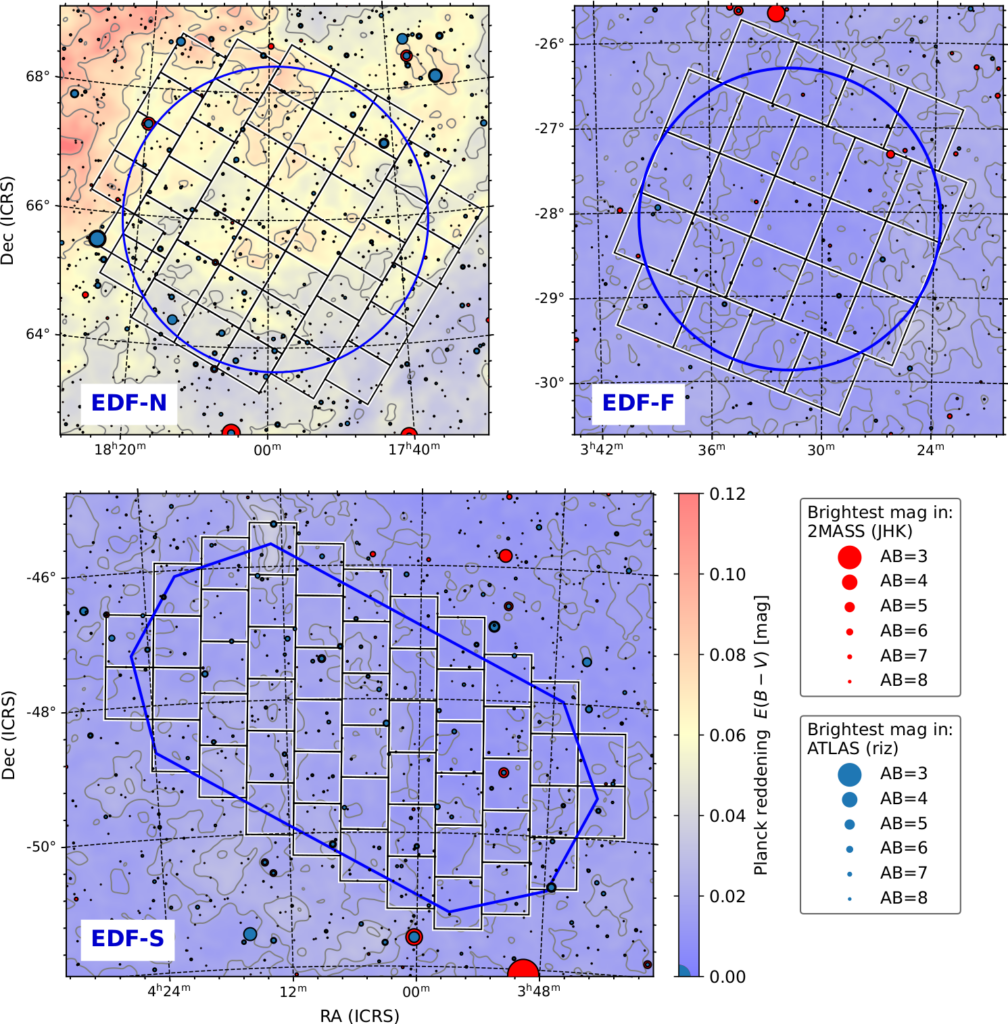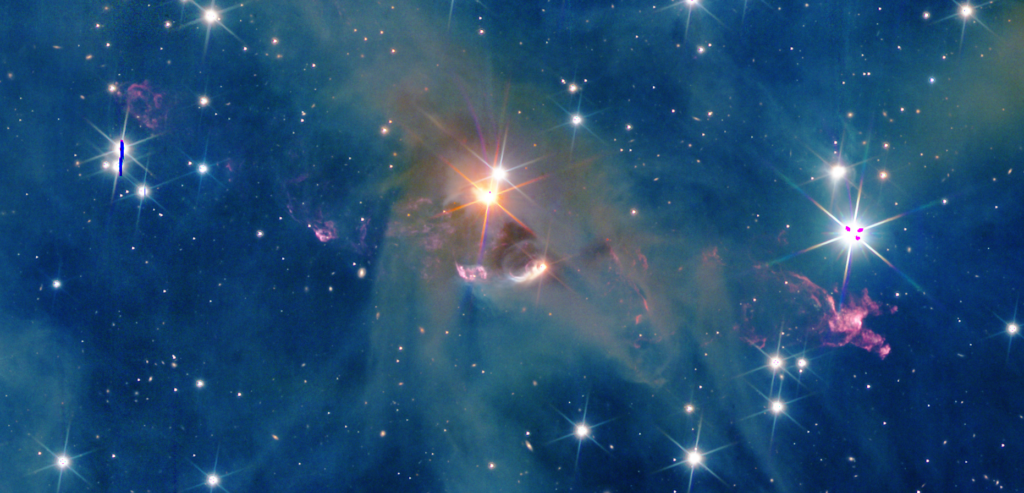Euclid data release: Q1
Euclid has a number of planned data releases to the world. The first one is the “Quick Data Release 1” or Q1 for short, that released 63.1 deg² of wide-survey science data on 19 March 2025. This release, containing approximately 26 million detections, is not a cosmology release but primarily aimed at a variety of astrophysical studies, providing VIS and NISP images, NISP spectroscopy, external ground-based data, catalogues, and masks. A total or seven technical publications and a supplement describe the content of the release. An overview is given in Euclid Collaboration: Aussel et al., 2025, “Euclid Quick Data Release (Q1) – Data release overview”. A constantly updated list of Q1 reference and science papers is given below. Complete information is available at ESA’s Q1 data release page, with a detailed description in the release’s Explanatory Supplement, and with a specific pointer to the Release Notes.
Basic data release information
Fields

| Field | Q1 area [deg²] | DR3-depth area [deg²] | RA [deg] | Dec [deg] | λ [deg] | β [deg] | DR3 visits |
| EDF-N | 22.9 | 20 | 269.733 | +66.018 | 258.690 | +89.446 | 40 |
| EDF-S | 28.1 | 23 | 61.241 | –48.423 | 36.493 | –66.599 | 45 |
| EDF-F | 12.1 | 10 | 52.932 | –28.088 | 40.772 | –45.397 | 52 |
| DC | 0.5 | – | 85.75 | –8.367 | 85.05 | –31.733 | 17 (Q1) |
DC is the `Dark Cloud’, Lynd’s Catalogue of Dark Nebulae (LDN) 1641 in Orion A, observed as a guiding calibration field during Euclid commissioning.
Data products released
- VIS and NISP calibrated single epoch image and 2d spectra frames
- Merged (MER) mosaics stacked tiles of VIS and NISP images
- Ground-based EXTernal calibrated Euclid images as MER stacked tiles in the g, r, i, and z bands
- NISP calibrated coadded 1d spectra
- Spectroscopic redshift catalogues
- Catalogues of detections based on VIS with information in all bands
- Masks for RMS, sky coverage, point-spread-functions, and more
Data access
Q1 data can be accessed through ESA’s Euclid Science Archive (https://eas.esac.esa.int/sas) where catalogues can be queried and a cutout service is available.
These data are also available through Python with the Euclid astroquery toolkit. Due to the large size of the FITS files we promote the use of the ESA Datalabs platform (https://datalabs.esa.int).
A subset of the data can be accessed through ESA Sky (https://sky.esa.int).
The data and their structure are described in the Q1 Data Product Description Document (DPDD).

Q1 publications
Euclid Q1 overview, data products and processing:
- Euclid Quick Data Release (Q1): Data Release Overview, Euclid Collaboration: Aussel et al. (2025)
- Euclid Quick Data Release (Q1): VIS processing and data products, Euclid Collaboration: McCracken et al. (2025)
- Euclid Quick Data Release (Q1): NIR processing and data products, Euclid Collaboration: Polenta et al. (2025)
- Euclid Quick Data Release (Q1): From Images to Multiwavelength Catalogues: the Euclid MERge Processing Function, Euclid Collaboration: Romelli et al. (2025)
- Euclid Quick Data Release (Q1): Photometric redshifts and physical properties of galaxies through the PHZ processing function, Euclid Collaboration: Tucci et al. (2025)
- Euclid Quick Data Release (Q1): From spectrograms to spectra: the SIR spectroscopic processing function, Euclid Collaboration: Copin et al. (2025)
- Euclid Quick Data Release (Q1): SPE Processing and Data Products, Euclid Collaboration: Le Brun et al. (2025)
Scientific results using Euclid Q1 data:
- Euclid Quick Data Release (Q1): Exploring galaxy morphology across cosmic time through Sérsic fits, Euclid Collaboration: Quilley et al. (2025)
- Euclid Quick Data Release (Q1): First Visual Morphology Catalogue, Euclid Collaboration: Walmsley et al. (2025b)
- Euclid Quick Data Release (Q1): A first look at the fraction of bars in massive galaxies at z < 1, Euclid Collaboration: Huertas-Company et al. (2025)
- Euclid Quick Data Release (Q1): A first look at a multimodal autoregressive foundation model for exploring galaxy properties, Euclid Collaboration: Siudek et al. (2025)
- Euclid Quick Data Release (Q1): The evolution of the passive-density and morphology-density relations up to z ∼ 1 in Q1, Euclid Collaboration: Cleland et al. (2025)
- Euclid Quick Data Release (Q1): A first view of the star-forming main sequence in the Euclid Deep Fields, Euclid Collaboration: Enia et al. (2025)
- Euclid Quick Data Release (Q1): A probabilistic classification of quenched galaxies, Euclid Collaboration: Corcho-Caballero et al. (2025)
- Euclid Quick Data Release (Q1): Optical and near-infrared identification and classification of point-like X-ray selected sources in Q1, Euclid Collaboration: Roster et al. (2025)
- Euclid Quick Data Release (Q1): First Euclid statistical study of galaxy mergers and their connection to Active Galactic Nuclei, Euclid Collaboration: La Marca et al. (2025)
- Euclid Quick Data Release (Q1): First Euclid statistical study of AGN power fraction, Euclid Collaboration: Margalef-Bentabol et al. (2025)
- Euclid Quick Data Release (Q1): First study of red quasars selection, Euclid Collaboration: Tarsitano et al. (2025)
- Euclid Quick Data Release (Q1): The active galaxies of Euclid, Euclid Collaboration: Matamoro Zatarain et al. (2025)
- Euclid Quick Data Release (Q1): AGN identification using diffusion-based inpainting of Euclid VIS images, Euclid Collaboration: Stevens et al. (2025)
- Euclid Quick Data Release (Q1): An investigation of optically faint, red objects in the Euclid Deep Fields, Euclid Collaboration: Girardi et al. (2025)
- Euclid Quick Data Release (Q1): Extending the quest for little red dots to z < 4, Euclid Collaboration: Bisigello et al. (2025)
- Euclid Quick Data Release (Q1): The Strong Lensing Discovery Engine A – System Overview and First Lens Sample, Euclid Collaboration: Walmsley et al. (2025a)
- Euclid Quick Data Release (Q1): The Strong Lensing Discovery Engine B – Early strong lens candidates from visual inspection of high velocity dispersion galaxies, Euclid Collaboration: Rojas et al. (2025)
- Euclid Quick Data Release (Q1): The Strong Lensing Discovery Engine C – Finding Lenses with Machine Learning, Euclid Collaboration: Lines et al. (2025)
- Euclid Quick Data Release (Q1) The strong lensing discovery engine D – double source plane lens candidates and cosmological forecast, Euclid Collaboration: Li et al. (2025)
- Euclid Quick Data Release (Q1): The strong lensing discovery engine E – ensemble classification of strong gravitational lenses: lessons for Data Release 1, Euclid Collaboration: Holloway et al. (2025)
- Euclid Quick Data Release (Q1): LEMON — Lens Modelling with Neural networks. Automated and fast modelling of Euclid gravitational lenses with singular isothermal ellipsoid mass profile, Euclid Collaboration: Busillo et al. (2025)
- Euclid Quick Data Release (Q1): The first catalogue of strong-lensing galaxy clusters, Euclid Collaboration: Bergamini et al. (2025)
- Euclid Quick Data Release (Q1): A catalogue of Spitzer galaxy overdensities at z>1.3 in the Q1 data release, Euclid Collaboration: Mai et al. (2025)
- Euclid Quick Data Release (Q1): The role of cosmic web connectivity in shaping galaxy clusters, Euclid Collaboration: Gouin et al. (2025)
- Euclid Quick Data Release (Q1): Galaxy shapes and alignments in the cosmic web, Euclid Collaboration: Laigle et al. (2025)
- Euclid: Quick Data Release (Q1): Photometric studies of known transients, Duffy et al. (2025)
- Euclid: Quick Data Release (Q1): A census of dwarf galaxies across a range of distances and environments, Marleau et al. (2025)
- Euclid Quick Data Release (Q1). First detections from the galaxy cluster workflow, Bhargava et al. (2025)
- Euclid Quick Data Release (Q1). The Euclid view on Planck galaxy protocluster candidates: towards a probe of the highest sites of star formation at cosmic noon, Dusserre et al. (2025)
- Euclid Quick Data Release (Q1) Ultracool dwarfs in the Euclid Deep Field North, Mohandasan et al. (2025)
- Euclid Quick Data Release (Q1): A photometric search for ultracool dwarfs in the Euclid Deep Fields, Zerjal et al. (2025)
Updated: 2025-04-02, KJ
